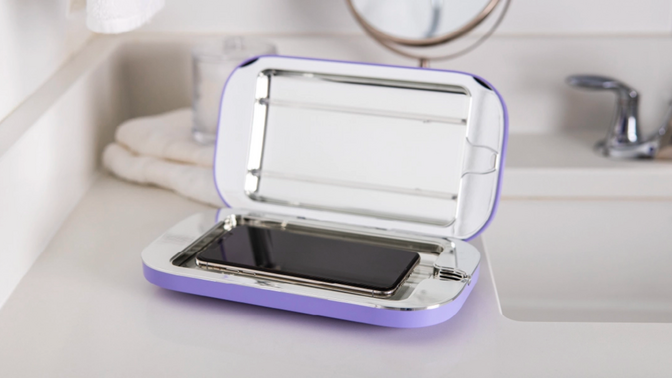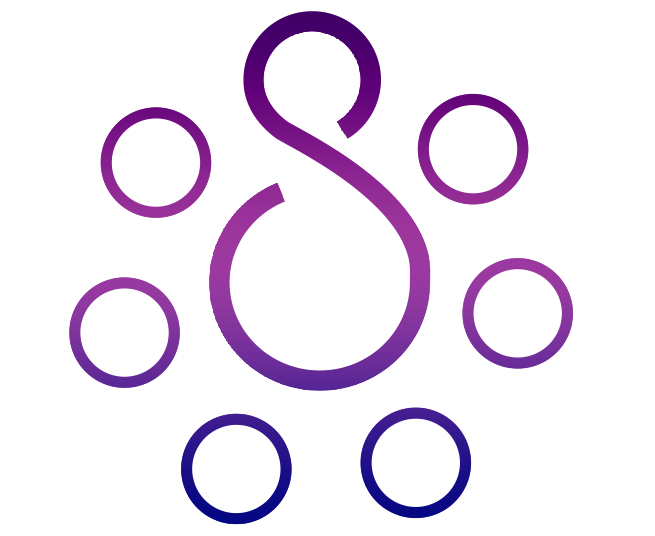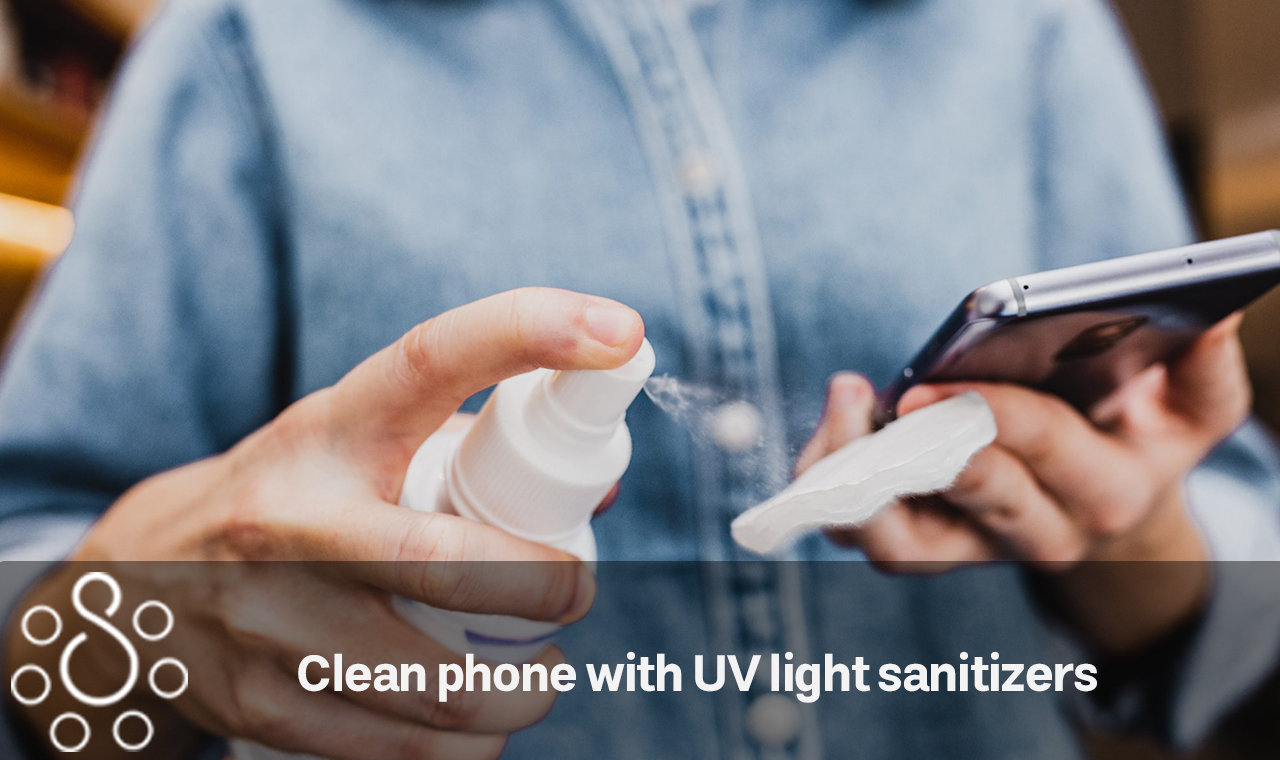Smartphones are infamous for being grumpy. You’ve undoubtedly heard comparisons to toilet seats before: Depending on who you ask, the typical phone is anywhere between seven and ten times dirtier than the majority of porcelain thrones, and one in six is allegedly tainted with feces. (Really an evil thing.) If you check your phone as often as the majority of people, which is once every 10 minutes, you’re exposed to a lot of germs. Apple, Google, and prominent Android manufacturers like Samsung, LG, Huawei, and Motorola all advise wiping down your phone with a soft, lint-free cloth, a small amount of warm, soapy water, and a dab of rubbing alcohol if it’s beginning to smell bad. But like with cleaning any electrical gadget, a very delicate approach is needed here: If excess moisture enters a port or crack, it will cause significant damage. It doesn’t take much, as I can attest from having destroyed an Xbox controller in this manner. Additionally, you run the danger of removing the screen’s protective layer, making it more susceptible to fingerprints and smudges. Follow us to find out more about UV phone sanitizers.
When you quickly wipe off your phone, keep in mind that you really have no way of knowing if you missed an area; those poop germs might still be there while you text, speak, and watch TikTok. There must be a better approach, right? At least that is the main premise of UV phone sanitizers.
What precisely is a UV phone sanitizer?
In the medical profession, sanitizing devices that utilize UV light to kill infections and superbugs have been known for decades, but consumer-friendly versions are a more recent innovation that have been widely used in response to the COVID-19 outbreak. (See also UV sanitizing wands and UV air purifiers; both open in new tabs.) A UV phone sanitizer is basically simply a little plastic or metal box with a few UV lamps or bulbs inside that light up your smartphone while it is being disinfected. The most apparent benefit, in addition to eliminating moisture, odors, and residue, is the simple convenience: You just insert your phone into the chamber of the sanitizer, secure the lid, and wait for it to finish for five to ten minutes. Make sure to remove your gadget from its case before disinfecting it for optimal results; you may run it through separately afterwards. There should also be room for other little items like PopSockets, keys, credit cards, glasses, smartwatches, and headphones.
Related Article: What UV light is best for plants
How can UV light destroy bacteria?
The electromagnetic radiation known as UV light is often found in the form of sunshine, but it may also be produced by employing artificial light sources. UV rays come in three main varieties:
The longest wavelengths are seen in UV-A photons. These may be found in tanning booths, insect zappers, and the blacklights at your neighborhood club. The wavelengths of UV-B photons are somewhat shorter. These are often employed in tanning beds in combination with UV-A radiation and may aid in the production of vitamin D3 by the skin (but can also result in sunburn). The wavelengths of UV-C photons are the shortest. These are often used for disinfection since they may harm the DNA of microorganisms. This either causes them to die instantly or stops them from living and procreating. From here on, whenever UV light is mentioned, it always refers to UV-C rays.
Is UV radiation harmful?
Even though UV light poses a greater threat to microbes than to people, the US Food and Drug Administration advises using some care while near it: “Some UVC lamps’ direct UV-C radiation exposure to skin and eyes may result in severe eye damage and skin responses that resemble burns.” Never, not even for a second, gaze directly at a UVC light source. ” The FDA also mentions that UV radiation may break down plastic and polymers, but don’t worry—it would take hours of continuous exposure to harm your phone significantly.
Do UV phone sanitizers really clean phones?
Steven Winkelman, a consumer electronics expert for PCMag, has previously covered this subject in-depth. (Full disclosure: ZiffDavis, the publisher of Mashable, also owns PCMag.) We won’t go through everything again, but the main points are as follows: Sort of.
While UV light itself is quite effective in eradicating and preventing the transmission of some germs, such as E. coli and Salmonella, the UV sanitizers available for sale to the general public are somewhat small in comparison to those used in hospitals. According to the FDA, “many of the UVC lamps available for household use are of low dosage,” meaning that they could need more exposure to a given surface area before a bacterium or virus is effectively inactivated. To that end, it’s also crucial to remember that, despite claims made by the majority of manufacturers that their UV phone sanitizers are 99.99 percent efficient against typical bacteria, very few of them can support these assertions with independent laboratory testing. We already know that keeping ourselves free of germs may be accomplished by washing our hands often, using face masks, avoiding crowded places, and being immunized. All of these practices are either totally free or very inexpensive. Overall, UV sanitation ought to be your “second line of protection” against viruses and bacteria, according to Winkelman.
Are COVID-19 UV sanitizers effective?
The C OVID-19 virus, SARS-CoV-2, is capable of being destroyed by UV light, according to the National Academies of Sciences, Engineering, and Medicine. However, there is a significant caveat: None of the consumer-grade UV phone sanitizers have been lab-tested against COVID, not even the rare few that have been tested against other microorganisms. “[Only] agencies like the CDC and others trying to control COVID-19 have access to this unusual strain of coronavirus to test,” said PhoneSoap, a manufacturer of UV sanitizers for at-home usage. As Winkelman points out, “[studies] suggest the virus is seldom viable on surfaces, and the CDC adds that transmission through contaminated surfaces” is not considered to be a typical method by which COVID-19 spreads.” Keep in mind that COVID is largely an airborne virus. You would likely be better off with a face mask and a Moderna or Pfizer shot if you were considering purchasing a UV sanitizer just for COVID prevention.
Related Article: Is UV-C light harmful for air ducts and electronics?
Which UV phone sanitizer is the best?
If the mention of PhoneSoap drew your attention, it may be because you saw it on Shark Tank in 2015, learned about its collaboration with Otterbox, or simply because it is the most well-known brand in the industry. The company offers a large selection of UV sanitizing products that have all passed rigorous laboratory testing. These products include a number of fully functional UV phone sanitizers with built-in chargers, unique acoustic outlets that allow you to hear alerts, and antimicrobial cables. For these reasons, we recommend PhoneSoap’s products over all competitors for most use scenarios. (A few exceptions apply.) Here’s the skinny:
The most recent version of PhoneSoap’s infamous TV and Kickstarter sanitizers, with over 6,500 five-star reviews on Amazon, is our favorite all-arounder. There is no need to switch your phone over and start another cycle since it has two UV lights that sanitize the front and back of your phone at the same time. It also includes two universal connectors that allow you to charge your phone even after the sanitizing procedure is over. It also helps that it is considerably under $100 and has seven stylish hues.
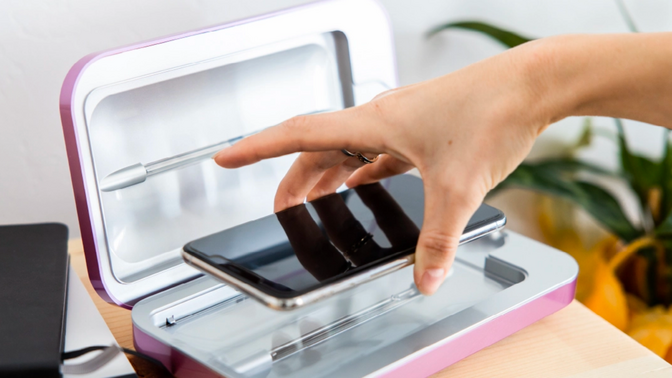
Most UV phone sanitizers need between five and ten minutes to complete a cycle. Just 30 seconds are required by the simplehuman cleanstation (opens in a new tab). Its chamber, which contains 30 high-intensity UV LED lights and highly reflective metal to ensure that the rays reach every square inch of your phone, is where the magic happens. The cleanstation is fully automated, so you never have to touch anything while it’s being sanitized—another awesome feature. The gadget automatically lowers your phone into the chamber after you place it in its slot, which includes foam composite doors to keep UV rays from escaping. You may wash your hands while it works; as soon as the cycle is over, the speaking, clean phone will pop back out.
Related Article: Learning to use and set up Surya Professional disinfectant with UV-C sterilizer box
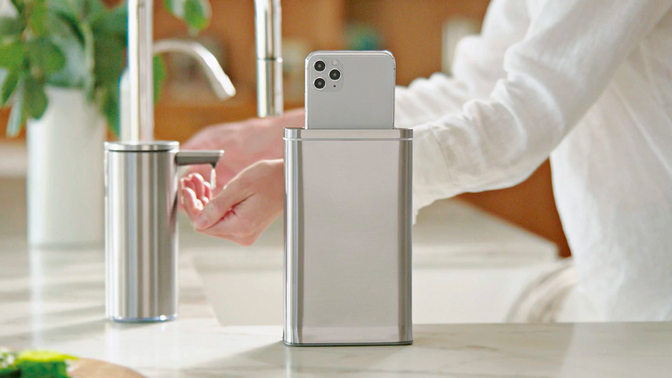
Your next best option for quick sanitizing, if you don’t have $200 for a cleanstation (quite reasonable), is the $120 PhoneSoap Pro (opens in a new tab). It’s slightly bigger than the PhoneSoap 3 and twice as quick; your phone gets clean in five minutes as opposed to ten thanks to the double UV lights and vacuum-plated aluminum inner shell. It has dual automatic and manual modes, much like the HomeSoap. The $120 UV sanitizer from the phone accessory company Casetify (opens in a new tab) works even quicker and enables wireless charging, but as far as we know, it hasn’t been put through any scientific testing.
